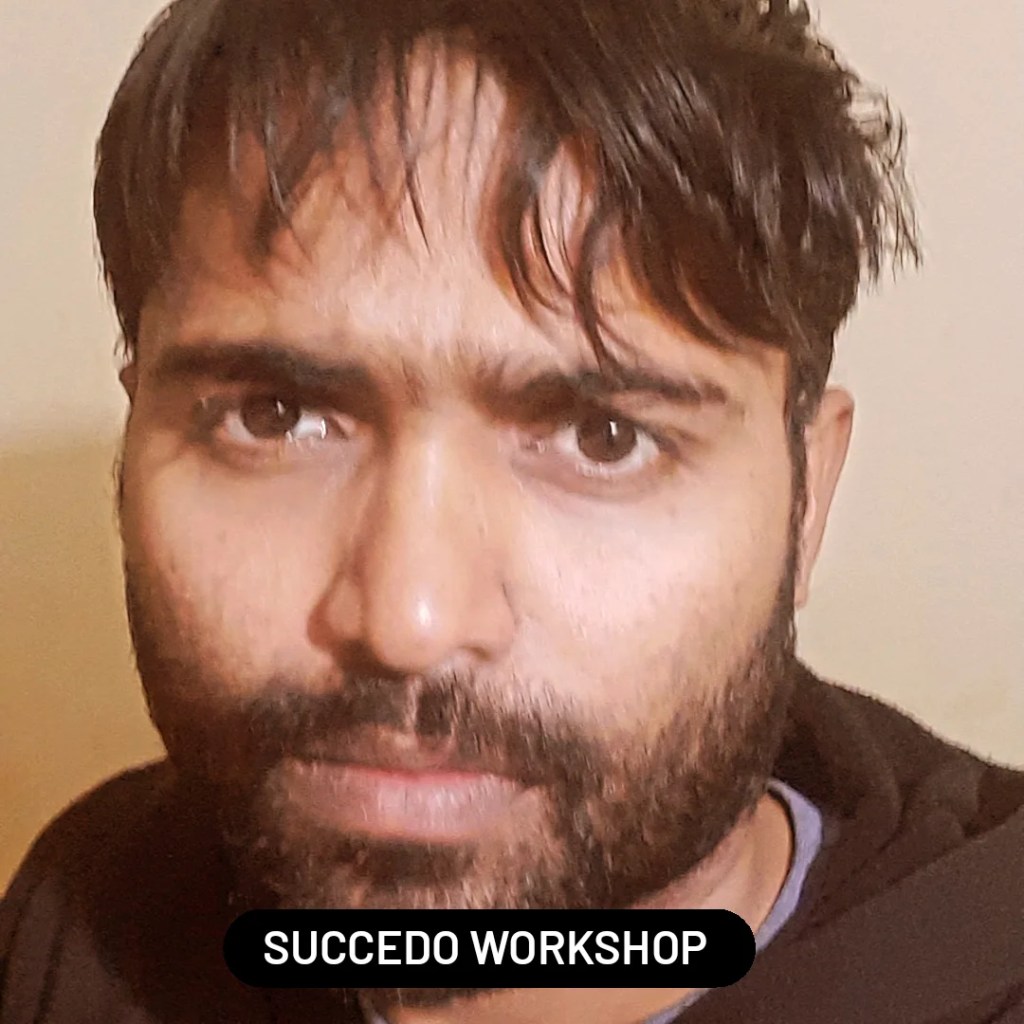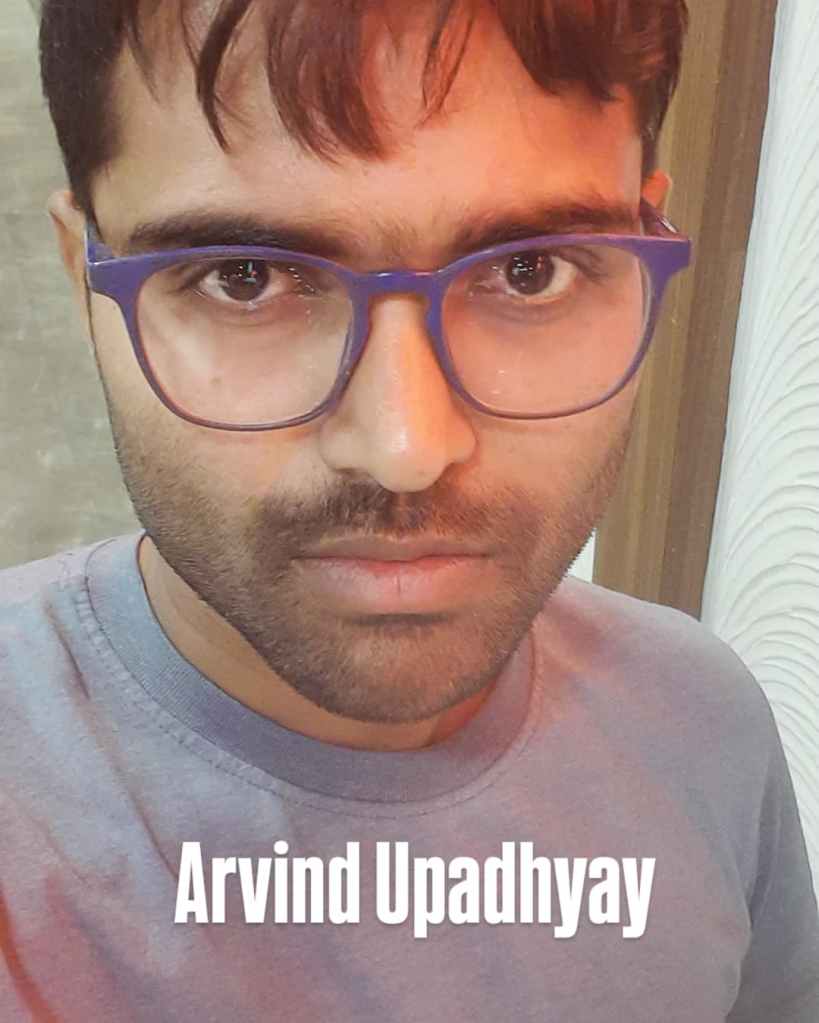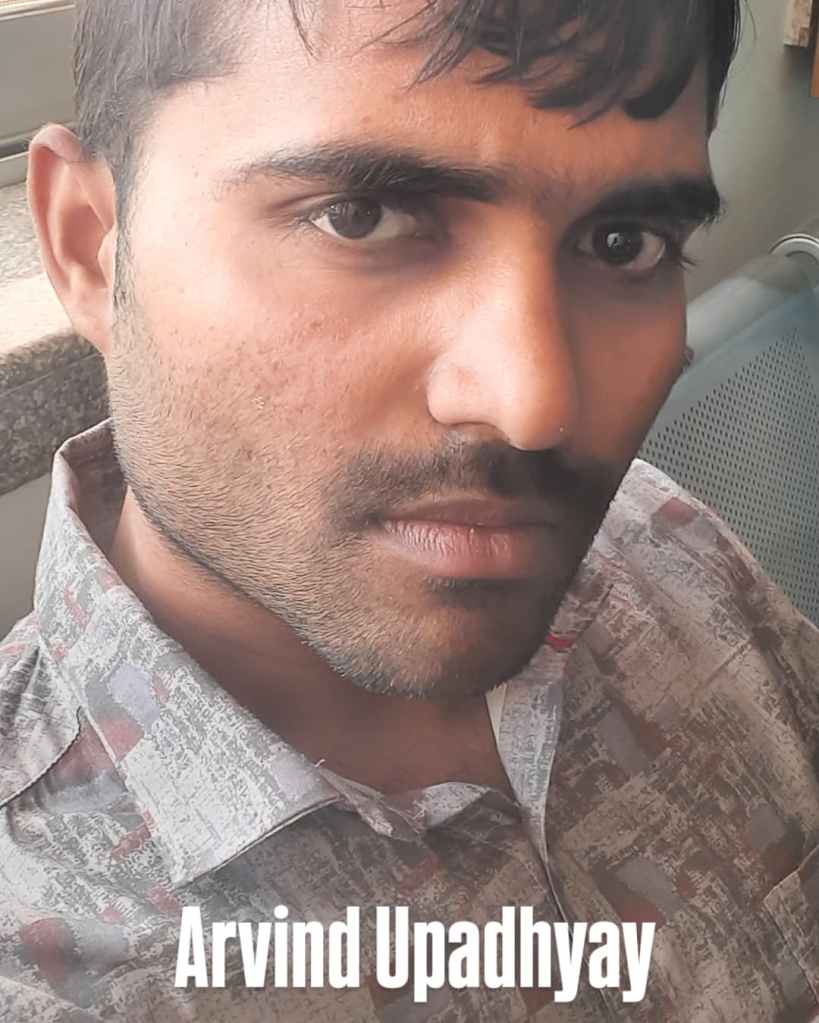Ready To Live an extraordinary life ? Start With Arvind Upadhyay
Ready To Take Your Life to New Height?
Transform Your Life In 2 days With Succeedo Movement By Arvind Upadhyay
#1 Business & Life Strategist.
Your Path to success is one Click Away. Here
Author of 100+ Self-help, Business Books.
Arvind Upadhyay is an Indian author, motivational speaker, and business coach who has written over 110 books on various topics such as self-help, personal success, financial success, leadership, sales success, and more. He is considered to be one of the leading experts in personal and professional development in India.
Hire Arvind Upadhyay Or Talk To Him For 1 Hour Pay with UPI on 7741049713
1.On Video Call 1 Hour – Rs 499, For Half Hours 300Rs
2. For Your Event To speak Rs 30,000 . It Depends on Your City & Location talk On 7741049713 For More .
Arvind Upadhyay Advice & Coaching & Strategy for Business And Life- Lifetime Cost only 79000 Rs . Unlimited Support, Guidence, Advice, freeTalk , Events , And More .
Arvind Upadhyay On YouTube
1.Arvind Upadhyay Leadership Coach
Arvind Upadhyay is a Entrepreneur, Author, Motivational Speaker, Business And Life Coach . He is the author of Over 100 Books On Self-help and Personal Growth. He is very Popular For His Self-help Books And Life Changing Seminars. Visit Arvind Upadhyay Official Website Here












-
How To Become Best At Anything

Arvind Upadhyay How to Become the Best at Anything
By Arvind Upadhyay
Becoming the best at anything is not about luck—it’s about strategy, discipline, and relentless execution. Whether you want to be the best in business, sports, leadership, or any skill, the formula for mastery remains the same. After years of experience as an author, motivational speaker, and business strategist, I have identified a clear path that separates the best from the rest.
If you truly want to be the best, follow these principles:
1. Master the Fundamentals
Greatness is built on a strong foundation. Whatever field you are in, start by mastering the basics.
- If you want to be the best writer, master storytelling and communication.
- If you want to be the best entrepreneur, master problem-solving, leadership, and financial literacy.
- If you want to be the best athlete, master fitness, discipline, and technique.
The best don’t chase shortcuts—they obsess over fundamentals.
2. Relentless Practice with Improvement
Repetition alone is not enough. You must practice with the intent to improve.
- Analyze what’s working and what’s not.
- Learn from feedback and adjust your strategy.
- Push yourself beyond your comfort zone.
The best athletes, musicians, and business leaders are never satisfied with “good enough.” They practice deliberately, improving a little every day.
3. Learn from the Best
Success leaves clues. Study the people who have already achieved what you want.
- Read their books, listen to their podcasts, and watch their interviews.
- Find mentors who can guide you and accelerate your learning.
- Observe how they think, act, and solve problems.
Surround yourself with people who are already where you want to be.
4. Develop an Unbreakable Mindset
Talent and intelligence are useless without the right mindset. The best have:
- Extreme focus – They eliminate distractions and concentrate on their goals.
- Resilience – They don’t quit when they fail; they learn and adapt.
- Confidence – They believe in themselves even when no one else does.
Your mindset determines your success more than your skills.
5. Outwork Everyone
Hard work beats talent when talent doesn’t work hard. If you want to be the best, you must be willing to work harder than anyone else.
- Show up early and stay late.
- Put in more effort, more hours, and more energy than your competitors.
- Never settle for average.
The best don’t wait for opportunities—they create them through relentless effort.
6. Stay Consistent for Years
Success is not an overnight event. It takes years of consistent effort.
- Stay committed even when results are slow.
- Keep showing up every single day.
- Focus on long-term mastery, not short-term wins.
Most people quit too soon. The best keep going until they win.
7. Never Stop Learning
No matter how good you become, there is always more to learn.
- Read every day.
- Take courses and attend workshops.
- Stay updated with new trends and innovations in your field.
The best never stop improving because they know growth is endless.
Conclusion: The Best Never Settle
If you want to be the best at anything, commit to excellence, work harder than anyone else, and never stop improving. The journey to mastery is long, but those who stay consistent will always rise to the top.
Ask yourself today: Are you willing to do what it takes to become the best?
Your success is in your hands. Now go and claim it.
-
Are You going to be proud of yourself in next 5 years

Arvind Upadhyay Will You Be Proud of Yourself in the Next 5 Years?
By Arvind Upadhyay
In the fast-paced world we live in, time is the one resource we can never get back. Five years may seem like a long time, but it will pass in the blink of an eye. The question you need to ask yourself today is: Will you be proud of who you become in the next five years?
As someone who has spent the last five years as an author, motivational speaker, and business and life strategist, I have witnessed firsthand how small, consistent actions shape a person’s destiny. Your future self is being created right now with the decisions you make, the habits you build, and the mindset you develop.
The Power of Vision
Most people underestimate what they can achieve in five years but overestimate what they can do in a single year. Success is not about sudden breakthroughs—it’s about the compounding effect of daily efforts. If you want to be proud of yourself in the future, you need to start by having a clear vision of what you want.
Ask yourself:
Where do I see myself in five years?
What kind of person do I want to become?
What impact do I want to create?
Write it down. Visualize it daily. Let it be the guiding force in your journey.
Your Habits Define Your Future
It’s not your goals but your habits that will determine your success. If you want to be proud of yourself five years from now, focus on building habits that align with your vision.
Read and learn every day. Knowledge compounds over time.
Take care of your health—physically and mentally.
Surround yourself with people who inspire and push you forward.
Take action, no matter how small, towards your dreams every single day.
Remember, consistency beats intensity. A small step forward every day is more powerful than a giant leap once in a while.
Overcoming Self-Doubt and Fear
One of the biggest obstacles between you and your future success is fear—fear of failure, fear of judgment, and fear of stepping out of your comfort zone. But here’s the truth: If you never step outside your comfort zone, your future self will look back with regret.
Instead of avoiding challenges, embrace them. Every challenge is an opportunity to grow. Every failure is a lesson that brings you one step closer to success.
Taking Full Responsibility
To become someone you’re proud of, you need to take full ownership of your life. Stop blaming circumstances, people, or bad luck. Successful people don’t wait for opportunities; they create them.
Ask yourself:
What can I do today to make my future self proud?
What excuses am I making that are holding me back?
How can I take responsibility for my growth and success?
The moment you take control of your life, everything changes.
The Future Starts Now
Five years from now, you will either look back with pride or with regret. The choice is yours. The actions you take today, the mindset you develop, and the discipline you build will determine whether you will be proud of yourself or not.
So, start now. Take the first step towards your goals. Make the difficult choices that will shape your success. And remember, the greatest investment you will ever make is in yourself.
When the next five years pass and you look back, make sure you can say with confidence, “I did my best, and I am proud of the person I have become.”
The journey starts today. Are you ready?
-
Daily habits for Successful People
7 Daily Habits of Highly Successful People
Success doesn’t happen overnight. It’s the result of consistent effort, deliberate choices, and habits that compound over time. Highly successful people—whether entrepreneurs, artists, athletes, or leaders—share common daily practices that fuel their productivity, resilience, and growth. Below, we explore seven key habits that set them apart, along with practical insights on how to integrate them into your own life.
1. Start the Day with Purpose
Successful individuals don’t stumble into their mornings—they design them. A common habit is waking up early to establish control over the day before distractions take hold. This often includes a structured morning routine tailored to their goals.
- What They Do: Many begin with mindfulness practices like meditation, journaling, or gratitude exercises to set a positive tone. Others review their goals or plan their day to align actions with priorities.
- Example: Oprah Winfrey has spoken about her morning ritual of meditation and reflection, which she credits for keeping her grounded amid a busy life.
- How to Apply: Wake up 30 minutes earlier than usual. Use the time to clarify your top three priorities for the day and engage in one calming activity, like deep breathing or stretching.
2. Prioritize Deep Work
Highly successful people protect time for focused, uninterrupted work on their most impactful tasks. They understand that multitasking dilutes effectiveness and that real progress comes from concentrated effort.
- What They Do: They block off specific hours for “deep work”—a term coined by author Cal Newport—where they tackle complex problems or creative projects without distractions.
- Example: Bill Gates famously takes “Think Weeks,” retreating twice a year to focus solely on reading and strategizing, a habit that shaped Microsoft’s innovation.
- How to Apply: Identify your most important task each day and dedicate 60-90 minutes to it, free from phone notifications or email checks. Start small and build consistency.
3. Embrace Lifelong Learning
Success hinges on adaptability, and successful people make learning a daily habit. They stay curious, seeking knowledge to refine their skills and stay ahead in their fields.
- What They Do: They read books, listen to podcasts, take courses, or engage in conversations with mentors. This isn’t passive consumption—it’s active exploration tied to their goals.
- Example: Warren Buffett reportedly spends 80% of his day reading and thinking, attributing his investment success to a relentless pursuit of knowledge.
- How to Apply: Commit to 20 minutes of learning daily—read a chapter of a book, watch an educational video, or study a new skill relevant to your aspirations.
4. Exercise for Body and Mind
Physical activity isn’t just about health—it’s a performance enhancer. Successful people incorporate exercise into their routines to boost energy, sharpen focus, and manage stress.
- What They Do: Whether it’s running, yoga, weightlifting, or a brisk walk, they treat exercise as non-negotiable. Many schedule it early to kickstart their metabolism and mood.
- Example: Richard Branson credits his daily workouts—tennis, kite surfing, or cycling—with giving him the stamina to run Virgin Group.
- How to Apply: Aim for 30 minutes of movement daily. It doesn’t have to be intense—choose something enjoyable like dancing or hiking to make it sustainable.
5. Practice Discipline Over Motivation
While motivation is fleeting, discipline keeps successful people consistent. They don’t wait to “feel like” doing something—they act regardless of mood, relying on systems and habits.
- What They Do: They create routines and stick to them, even on tough days. This might mean writing 500 words daily, reviewing finances, or practicing a craft, no matter the circumstances.
- Example: Author Stephen King writes 2,000 words every day, a habit he’s maintained for decades, producing over 60 novels.
- How to Apply: Build a simple system for one goal (e.g., 10 push-ups daily or 15 minutes of planning). Do it at the same time each day until it becomes automatic.
6. Connect and Network Intentionally
Success rarely happens in isolation. High achievers invest in relationships, both personal and professional, knowing that collaboration and support amplify their efforts.
- What They Do: They reach out to mentors, colleagues, or friends regularly—not just when they need something. They also give back, offering help or insights to others.
- Example: Elon Musk has built a network of brilliant minds at Tesla and SpaceX, often collaborating with experts to solve complex challenges.
- How to Apply: Send one thoughtful message a day—thank someone, ask a question, or share a resource. Over time, this strengthens your circle.
7. Reflect and Recharge
Successful people don’t just charge forward—they pause to assess and recover. Reflection helps them learn from mistakes, while rest prevents burnout and sustains long-term performance.
- What They Do: They end the day by reviewing what worked, what didn’t, and what to adjust. They also prioritize sleep and downtime to maintain clarity and creativity.
- Example: Arianna Huffington, after collapsing from exhaustion, became an advocate for sleep, calling it a “non-negotiable priority” for success.
- How to Apply: Spend 5-10 minutes each evening journaling about your day—wins, lessons, and next steps. Aim for 7-8 hours of sleep to recharge fully.
Why These Habits Work
These seven habits aren’t random—they’re rooted in principles of focus, growth, and balance. Starting with purpose sets direction, deep work drives results, and learning keeps you competitive. Exercise and discipline sustain momentum, while relationships and reflection ensure you’re not just busy, but effective. Together, they create a feedback loop of improvement.
Getting Started
You don’t need to overhaul your life overnight. Pick one habit that resonates most and practice it for a week. Track your progress and adjust as needed. Success isn’t about perfection—it’s about persistence. As these habits stack, you’ll find yourself not just doing more, but becoming more.
Highly successful people aren’t superhuman; they’re simply intentional. By adopting these daily practices, you can unlock your own potential, one day at a time.
-
The Power Of Positive Thinking
The Power of Positive Thinking: How It Shapes Your Success
Positive thinking isn’t just a feel-good mantra—it’s a transformative force that can reshape your life and pave the way to success. Far from being blind optimism, it’s a deliberate mental habit that influences how you perceive challenges, seize opportunities, and persist toward your goals. Backed by science and real-world evidence, this detailed article explores how positive thinking works, why it matters, and how you can harness it to unlock your potential.
What Is Positive Thinking?
Positive thinking is the practice of focusing on constructive, hopeful, and solution-oriented thoughts, even in the face of adversity. It’s not about ignoring reality or denying problems—it’s about approaching them with a mindset that emphasizes possibility over limitation. Think of it as a lens: instead of seeing a glass half empty, you see it half full, ready to be topped up with effort and ingenuity.
The Science Behind Positive Thinking
The power of positive thinking isn’t just anecdotal; it’s rooted in psychology and neuroscience:
- Brain Chemistry: Positive thoughts trigger the release of feel-good neurotransmitters like dopamine and serotonin, enhancing mood and motivation, according to a 2019 study in Nature Reviews Neuroscience.
- Stress Reduction: Optimists experience lower cortisol levels (the stress hormone), improving physical and mental resilience, per the American Psychological Association.
- Performance Boost: A 2011 study from the Journal of Personality and Social Psychology found that positive thinkers outperform pessimists in problem-solving and goal achievement due to enhanced focus and creativity.
- Health Benefits: Research from the Mayo Clinic links positive thinking to longer life expectancy, reduced depression, and stronger immunity.
In short, your thoughts don’t just reflect your reality—they actively shape it.
How Positive Thinking Shapes Success
Success isn’t an accident; it’s a byproduct of mindset and action. Here’s how positive thinking lays the groundwork:
1. It Fuels Resilience
Life is full of setbacks—lost jobs, failed projects, personal struggles. Positive thinkers see these as temporary hurdles, not permanent roadblocks.
- Example: After being fired from her first TV job, Oprah Winfrey chose to view it as a redirection, not a rejection. That optimism propelled her to global success.
2. It Sparks Creativity and Problem-Solving
A positive mind doesn’t dwell on “what’s wrong” but asks, “how can this work?” This shift opens up innovative solutions.
- Evidence: Barbara Fredrickson’s “Broaden-and-Build” theory shows that positive emotions expand your cognitive flexibility, making you more adaptable and resourceful.
3. It Builds Confidence
Believing in a positive outcome boosts your self-efficacy—the conviction that you can succeed. This confidence drives action where doubt would paralyze.
- Example: Athletes like Serena Williams use positive self-talk (“I’ve got this”) to maintain peak performance under pressure.
4. It Attracts Opportunities
Optimism isn’t magic, but it’s magnetic. Positive people radiate energy that draws others in—collaborators, mentors, or supporters who amplify their success.
- Real-World Impact: Studies in organizational psychology show that positive employees are more likely to be promoted due to their proactive attitude.
5. It Sustains Motivation
Goals take time, and negativity can sap your drive. Positive thinking keeps you focused on the “why” behind your efforts, making persistence feel worthwhile.
- Case Study: Thomas Edison’s 1,000+ attempts to invent the lightbulb were fueled by his belief that each “failure” brought him closer to success.
The Ripple Effect: Beyond Personal Success
Positive thinking doesn’t just benefit you—it transforms your relationships and environment:
- Social Bonds: A 2020 Journal of Happiness Studies report found that optimists foster stronger, more supportive networks.
- Workplace Impact: Teams led by positive thinkers show 31% higher productivity, per Gallup research.
- Emotional Contagion: Your positivity can inspire others, creating a cycle of upliftment.
How to Cultivate Positive Thinking
It’s not an innate trait—it’s a skill you can build. Here’s a practical roadmap:
1. Reframe Challenges
- Action: When faced with a problem, list three ways it could benefit you (e.g., a skill learned, a weakness exposed).
- Example: “I didn’t get the promotion” becomes “I now know what to improve for next time.”
2. Practice Gratitude
- Action: Write down three things you’re grateful for daily—simple joys or big wins. Do it for 30 days.
- Why: Gratitude shifts your focus from lack to abundance, rewiring your brain for positivity, per UCLA’s Mindfulness Research Center.
3. Use Affirmations
- Action: Repeat empowering statements like “I am capable of overcoming obstacles” or “Every step brings me closer to success” each morning.
- Why: Affirmations reinforce neural pathways for self-belief, per a 2016 Social Cognitive and Affective Neuroscience study.
4. Surround Yourself with Positivity
- Action: Curate your influences—follow uplifting voices, read inspiring books (e.g., The Power of Positive Thinking by Norman Vincent Peale), and limit toxic inputs.
- Why: Your environment shapes your mindset—choose wisely.
5. Visualize Success
- Action: Spend 5 minutes daily picturing your goals achieved in vivid detail—sights, sounds, feelings.
- Why: Visualization primes your subconscious to act as if success is inevitable, boosting effort and focus.
6. Replace Negative Self-Talk
- Action: Catch phrases like “I’m a failure” and swap them with “I’m learning.” Practice this consciously for a week.
- Why: Words shape your reality—positive language builds a positive self-image.
7. Take Action
- Action: Pair your optimism with small, consistent steps toward a goal. Success reinforces positivity.
- Why: Action proves your thoughts aren’t just wishful—it’s optimism in motion.
Overcoming Obstacles to Positive Thinking
- Cynicism: Start small—find one positive in a tough situation. Build from there.
- Overwhelm: Focus on the present moment, not the distant future. Ask, “What can I do right now?”
- Habitual Negativity: Track your thoughts for a day. Awareness breaks the cycle.
- External Negativity: Set boundaries with pessimists; their mindset isn’t your burden.
Real-Life Success Stories
- Nelson Mandela: Imprisoned for 27 years, he maintained hope and positivity, emerging to lead a nation.
- Steve Jobs: Fired from Apple, he saw it as a chance to innovate, returning to create a tech empire.
- Malala Yousafzai: Shot for advocating education, she turned trauma into a global movement with unwavering optimism.
Measuring the Impact
After 30 days of practicing positive thinking:
- Do you feel more energized or hopeful?
- Are you quicker to recover from setbacks?
- Have others noticed a shift in your demeanor?
Success isn’t just outcomes—it’s the strength you build along the way.
Final Thoughts
The power of positive thinking lies in its simplicity: it’s a choice you make daily. It doesn’t erase life’s challenges, but it equips you to face them with courage, creativity, and clarity. Success isn’t guaranteed by talent or circumstance—it’s forged by the way you think. Start today: pick one strategy, apply it, and watch how it ripples through your life. What positive thought will you hold onto right now?
-
How To Develop A Success Mindset
How to Develop a Success Mindset: The Ultimate Guide
A success mindset is the foundation of achieving your goals, overcoming obstacles, and living a fulfilling life. It’s not about luck or innate talent—it’s a deliberate way of thinking that anyone can cultivate with practice and intention. This detailed guide explores the core principles, actionable strategies, and psychological insights to help you develop a mindset primed for success. Let’s dive into the ultimate roadmap.
What Is a Success Mindset?
A success mindset is a mental framework that embraces growth, resilience, and proactive problem-solving. It’s the belief that challenges are opportunities, failures are lessons, and your potential is shaped by effort rather than fixed limitations. Rooted in psychology—particularly Carol Dweck’s concept of a “growth mindset”—it’s about seeing yourself as a work in progress, capable of evolving and succeeding through dedication.
Why a Success Mindset Matters
Your mindset dictates how you interpret experiences and respond to setbacks. Research shows that individuals with a success-oriented mindset:
- Persist longer in the face of adversity (resilience).
- Are more likely to take calculated risks (courage).
- Experience lower stress and higher satisfaction (well-being).
Without it, self-doubt, fear of failure, or a victim mentality can sabotage even the best-laid plans. Developing this mindset isn’t just a feel-good exercise—it’s a practical tool for tangible results.
The Core Pillars of a Success Mindset
To build this mindset, focus on these five foundational elements:
1. Self-Belief: Trust in Your Potential
Success begins with believing you’re capable. Doubt erodes effort, while confidence fuels action.
- Why it matters: A 2018 study from the Journal of Positive Psychology found that self-efficacy (belief in one’s abilities) strongly predicts goal attainment.
- How to develop it: Reflect on past wins—big or small—to remind yourself of your competence. Replace “I can’t” with “I’ll figure it out.”
2. Growth Orientation: Embrace Learning Over Perfection
A fixed mindset assumes abilities are static; a growth mindset sees them as malleable.
- Why it matters: People with a growth mindset outperform others in problem-solving and adaptability, per Dweck’s research.
- How to develop it: Reframe challenges as chances to grow. Ask, “What can I learn here?” instead of “Why did I fail?”
3. Resilience: Bounce Back Stronger
Setbacks are inevitable—resilience turns them into stepping stones.
- Why it matters: The American Psychological Association links resilience to lower rates of burnout and higher life satisfaction.
- How to develop it: Practice self-compassion after a failure. Break problems into manageable steps and tackle them one by one.
4. Purpose: Align Actions with Meaning
Success without purpose feels hollow. A clear “why” keeps you motivated.
- Why it matters: Purpose-driven individuals report 30% higher engagement, according to a Deloitte study.
- How to develop it: Define what success means to you—not society. Write a personal mission statement and revisit it often.
5. Discipline: Commit to Consistent Effort
Mindset without action is just a dream. Discipline bridges the gap.
- Why it matters: Habits account for 40% of our daily behavior, per Duke University research—consistency compounds.
- How to develop it: Start small. Commit to one daily action (e.g., 10 minutes of planning) and build from there.
Step-by-Step Guide to Developing a Success Mindset
Step 1: Audit Your Current Mindset
- Action: Spend 10 minutes journaling your thoughts about success. Do you see it as luck? Talent? Effort? Identify limiting beliefs like “I’m not smart enough” or “It’s too late.”
- Goal: Awareness is the first step to change.
Step 2: Reframe Negative Thinking
- Action: Catch yourself in moments of negativity. For every “This won’t work,” counter with “How can I make it work?”
- Tool: Use the “3 Cs” technique—Challenge (is this thought true?), Consider (what’s an alternative?), Change (adopt a new belief).
- Example: “I failed” becomes “I found a way that doesn’t work—yet.”
Step 3: Set Clear, Achievable Goals
- Action: Write SMART goals (Specific, Measurable, Achievable, Relevant, Time-bound). Example: “Read one book on leadership by April 15.”
- Why: Goals give direction; small wins build momentum.
Step 4: Surround Yourself with Positivity
- Action: Evaluate your circle—friends, media, environment. Seek out people who inspire and challenge you. Limit exposure to chronic negativity.
- Why: Social contagion theory suggests attitudes are infectious.
Step 5: Practice Visualization
- Action: Spend 5 minutes daily imagining your success in vivid detail—what it looks like, feels like, sounds like.
- Why: Visualization primes your brain for action, boosting confidence and focus, per a 2020 Neuroscience Letters study.
Step 6: Take Responsibility
- Action: Stop blaming external factors (time, money, others). Ask, “What’s in my control?” and act on it.
- Why: Ownership shifts you from victim to victor.
Step 7: Build a Routine
- Action: Design a daily schedule that supports your goals—morning reflection, skill practice, rest. Stick to it for 21 days.
- Why: Consistency turns intention into instinct.
Step 8: Celebrate Progress
- Action: Track milestones (e.g., a completed task, a learned skill) and reward yourself—a coffee, a break, a pat on the back.
- Why: Positive reinforcement strengthens neural pathways for motivation.
Common Obstacles and How to Overcome Them
- Fear of Failure
- Fix: Redefine failure as feedback. Thomas Edison didn’t fail 1,000 times—he found 1,000 ways not to make a lightbulb.
- Procrastination
- Fix: Use the “2-Minute Rule”—start with a task that takes less than 2 minutes (e.g., opening a book). Momentum follows.
- Overwhelm
- Fix: Break goals into bite-sized chunks. Focus on the next step, not the finish line.
- Self-Doubt
- Fix: Keep a “success log” of achievements to revisit when doubt creeps in.
Real-Life Examples of a Success Mindset
- J.K. Rowling: Rejected by 12 publishers, she persisted, believing in her story. Harry Potter became a global phenomenon.
- Elon Musk: After SpaceX’s early rocket failures, he reframed them as learning opportunities, leading to groundbreaking success.
- Oprah Winfrey: Overcoming poverty and trauma, she focused on purpose and resilience, building an empire.
Tools and Resources to Support Your Journey
- Books: Mindset by Carol Dweck, Atomic Habits by James Clear, The Power of Now by Eckhart Tolle.
- Apps: Habitica (habit-building), Headspace (mindfulness), Notion (goal-tracking).
- Practice: Daily affirmations—“I am capable,” “I grow through effort,” “I control my destiny.”
Measuring Your Success Mindset
Track your progress monthly:
- Do you approach challenges with curiosity or dread?
- Are you more proactive than reactive?
- How often do you bounce back from setbacks?
Growth isn’t linear—look for trends, not perfection.
Final Thoughts
Developing a success mindset is a lifelong commitment, but the payoff is immense: greater confidence, clarity, and achievement. It’s not about being flawless—it’s about being relentless in your pursuit of growth. Start today with one step—audit your thoughts, set a goal, or visualize your future. What will your success story be?
This guide is your blueprint. Take it, tweak it, and make it yours. Success awaits those who think it into existence.
-
10 Life-Changing Self-Improvement Tips You Need to Try
Change Your Life with Arvind Upadhyay Strategies.
Self-improvement is a journey that can transform your life, boost your confidence, and help you unlock your full potential. Whether you’re looking to enhance your mental well-being, sharpen your skills, or build better habits, these 10 practical and life-changing tips will set you on the right path. Let’s dive in!
1. Start Your Day with Intention
How you begin your morning sets the tone for the rest of the day. Instead of reaching for your phone to scroll aimlessly, take five minutes to set an intention. Write down one goal—big or small—that you want to focus on. This simple act primes your mind for purpose and productivity.
2. Embrace the Power of Small Habits
Massive change doesn’t require massive action—just consistent steps. Pick one tiny habit, like drinking a glass of water first thing in the morning or reading one page of a book daily. Over time, these micro-actions compound into remarkable results.
3. Practice Gratitude Daily
Gratitude shifts your mindset from scarcity to abundance. Each day, jot down three things you’re thankful for—whether it’s a warm meal, a kind gesture, or a personal win. Studies show this habit rewires your brain for positivity and resilience.
4. Learn to Say “No”
Your time and energy are precious. Saying “yes” to everything stretches you thin and leaves little room for what truly matters. Practice declining requests that don’t align with your goals or values—it’s a powerful way to reclaim control of your life.
5. Move Your Body Regularly
Exercise isn’t just for physical health; it’s a mental game-changer. You don’t need a gym—dance in your living room, take a brisk walk, or stretch for 10 minutes. Movement releases endorphins, reduces stress, and sharpens focus.
6. Limit Digital Distractions
We’re bombarded with notifications and endless feeds. Set boundaries: schedule “no-phone” zones (like during meals or before bed) and use tools to block distracting apps. Reclaiming your attention creates space for deeper thinking and real connections.
7. Invest in Lifelong Learning
Growth comes from curiosity. Pick up a new skill, read a challenging book, or listen to a podcast outside your comfort zone. Even 15 minutes a day of learning expands your mind and keeps you adaptable in a fast-changing world.
8. Master the Art of Listening
Self-improvement isn’t just about you—it’s about how you connect with others. Practice active listening: put away distractions, maintain eye contact, and reflect on what’s said before responding. It builds stronger relationships and sharpens your empathy.
9. Declutter Your Space and Mind
A cluttered environment often mirrors a cluttered mind. Start small—organize your desk or clear out a drawer. As you let go of physical baggage, pair it with mental decluttering: journal your thoughts or meditate to release what’s weighing you down.
10. Celebrate Your Progress
Too often, we fixate on what’s left to achieve instead of how far we’ve come. Take time to acknowledge your wins, no matter how small. Ran a mile? Finished a project? Celebrate it. Recognizing progress fuels motivation and self-worth.
Final Thoughts
Self-improvement isn’t about perfection—it’s about progress. Start with one or two of these tips and build from there. The key is consistency and self-compassion. You’re not just improving your life; you’re crafting a version of yourself you’re proud to be. Which tip will you try first?
-
Join Succeedo Movement Find Success In Life With Arvind Upadhyay
Join the Succedo Membership Event: Your Gateway to Lifelong Success
Are you ready to transform your life and unlock your true potential? Join us for the Succedo Membership Event, where Arvind Upadhyay, the World’s Best Business and Life Strategist and acclaimed author of over 100 books on self-help and business success, will guide you through an exclusive journey towards self-improvement and success.
Why Become a Member?
- Exclusive Access to Resources: As a member, you’ll gain access to a wealth of resources, including specialized workshops, masterclasses, and exclusive content designed to help you navigate your personal and professional growth effectively.
- Ongoing Support and Guidance: Membership offers continuous support from Arvind Upadhyay and a community of like-minded individuals. Engage in forums, group coaching sessions, and networking opportunities that foster collaboration and shared success.
- Personalized Development Plans: Receive tailored advice and strategies to help you set and achieve your goals. Our focus is on providing you with actionable steps that align with your unique aspirations.
- Interactive Events and Workshops: Members will enjoy invitations to exclusive workshops, webinars, and live events that deepen your learning and expand your skill set. These interactive sessions are designed to keep you engaged and motivated.
- Networking Opportunities: Connect with a diverse community of ambitious individuals, entrepreneurs, and professionals. Share experiences, learn from one another, and build lasting relationships that can propel your success.
Event Details
- Event Name: Succedo Membership Event
- Date & Time: 18th October 2024, 11 AM
- Location: Golf Club, Nashik, Maharashtra
- Format: Join us virtually or attend offline for a more immersive experience. Choose what suits you best!
- Virtual Access: Instructions for joining the online session will be provided upon registration.
How to Register
Don’t miss this chance to be part of something extraordinary. Take the first step towards a brighter future by joining the Succedo Membership Event.
To register and become a member, call 7741049713 today!
Conclusion
Transform your life and achieve your goals with the support of Arvind Upadhyay and the vibrant Succedo community. The Succedo Membership Event is not just an event; it’s a commitment to your personal and professional growth. Join us and unlock a world of opportunities that will empower you to succeed beyond your dreams.
Seize this opportunity, and let’s embark on this journey together!
-
How To Stay Focused Get Rid of Distraction
How to Stay Focused: Get Rid of Distractions Book By Arvind Upadhyay
Introduction:
In today’s fast-paced world, staying focused has become increasingly challenging. With the constant barrage of distractions from technology, social media, and everyday life, it’s easy to lose track of our goals and priorities. However, there are strategies and tools available to help us stay on track and maintain our focus. One such resource is the book “Get Rid of Distractions” by renowned author Arvind Upadhyay. In this article, we will explore how this book can help you improve your focus and productivity.How to Stay Focused with Arvind Upadhyay’s Book:
Arvind Upadhyay’s book “Get Rid of Distractions” offers a comprehensive guide on how to overcome distractions and stay focused on your tasks. Through a combination of practical tips, actionable strategies, and insightful anecdotes, Upadhyay provides readers with the tools they need to reclaim their focus and achieve their goals. From setting clear objectives to establishing an effective work environment, this book covers all aspects of staying focused in today’s digital age.
Key Strategies from the Book:
- Identify Your Distractions: The first step towards staying focused is to identify the specific distractions that are holding you back. Whether it’s social media, email notifications, or noisy environments, pinpointing your triggers is crucial for developing a targeted focus strategy.
- Create a Distraction-Free Environment: Designating a designated workspace free from distractions can significantly boost your productivity. Upadhyay’s book provides practical tips for setting up an optimal work environment, including minimizing clutter, reducing noise, and optimizing lighting.
- Establish a Routine: Consistency is key when it comes to maintaining focus. By establishing a daily routine that includes dedicated work periods and breaks, you can train your brain to focus more effectively over time.
- Practice Mindfulness: Mindfulness techniques, such as meditation and deep breathing exercises, can help sharpen your focus and improve your overall mental clarity. Upadhyay’s book offers practical mindfulness exercises that you can incorporate into your daily routine.
- Set Clear Goals: Setting specific, measurable goals is essential for staying focused and motivated. By breaking down larger tasks into smaller, more achievable milestones, you can track your progress and stay on course towards your objectives.
Conclusion:
In conclusion, staying focused in today’s digital age requires a proactive approach and a commitment to minimizing distractions. By implementing the strategies outlined in Arvind Upadhyay’s book “Get Rid of Distractions,” you can take control of your attention and boost your productivity. Remember, staying focused is a skill that can be developed and honed over time. With the right tools and mindset, you can achieve your goals and realize your full potential.
Meta Description: Learn how to improve your focus and productivity with “Get Rid of Distractions” book by Arvind Upadhyay. Discover practical tips and strategies to overcome distractions and stay on track.
By following the advice in Upadhyay’s book, you can take steps towards mastering your focus and achieving success in all areas of your life. So, why wait? Dive into the world of distraction-free productivity today! -
Maximizing Focus: Strategies for Eliminating Distractions
**Introduction:**
In today’s fast-paced world, staying focused is becoming increasingly challenging. With the constant barrage of notifications, emails, and other distractions, maintaining concentration on tasks has become a formidable feat. In his book, “How to Stay Focused: Get Rid of Distractions,” author Arvind Upadhyay provides valuable insights and strategies to help individuals reclaim their focus and achieve greater productivity. This article explores some of the key concepts outlined in Upadhyay’s book and offers practical tips for eliminating distractions.
**Understanding Distractions:**
Upadhyay delves into the nature of distractions and their impact on productivity. Distractions come in various forms, including digital distractions like social media notifications, as well as environmental distractions such as noise and clutter. He emphasizes the detrimental effects of multitasking, which can diminish productivity and cognitive performance. By understanding the root causes of distractions, individuals can better address them and improve their ability to stay focused.
**Creating a Distraction-Free Environment:**
One of the cornerstone strategies outlined by Upadhyay is the importance of creating a conducive environment for focus. This involves minimizing external distractions by decluttering the workspace, turning off notifications, and setting boundaries with colleagues and family members. Additionally, Upadhyay recommends leveraging technology tools, such as website blockers and time management apps, to limit digital distractions and stay on track with tasks.
**Practicing Mindfulness:**
Mindfulness is another key component of Upadhyay’s approach to staying focused. By cultivating mindfulness through practices such as meditation and deep breathing exercises, individuals can train their minds to become more resilient to distractions. Mindfulness techniques help increase self-awareness and enable individuals to redirect their attention back to the task at hand when distractions arise.
**Implementing Time Management Strategies:**
Effective time management is essential for maintaining focus and productivity. Upadhyay advocates for techniques such as the Pomodoro Technique, which involves working in focused bursts followed by short breaks. By breaking tasks into smaller, manageable chunks, individuals can avoid feeling overwhelmed and maintain momentum throughout the day.
**Setting Clear Goals:**
Having clear, specific goals is crucial for staying focused and motivated. Upadhyay emphasizes the importance of setting SMART goals – goals that are specific, measurable, achievable, relevant, and time-bound. By aligning daily tasks with overarching objectives, individuals can prioritize their activities and stay on track towards achieving their goals.
**Conclusion:**
In “How to Stay Focused: Get Rid of Distractions,” Arvind Upadhyay offers a comprehensive guide to overcoming distractions and maximizing productivity. By implementing strategies such as creating a distraction-free environment, practicing mindfulness, implementing time management techniques, and setting clear goals, individuals can enhance their ability to stay focused and achieve their desired outcomes. In today’s digital age, mastering the art of focus is more important than ever, and Upadhyay’s insights provide valuable tools for navigating the distractions of modern life. -
The SMART Way to Personal Growth: A Research-Based Approach
**
In the pursuit of personal growth, setting effective goals is paramount. While the concept of goal-setting is widely acknowledged, the SMART criteria provide a structured framework to ensure goals are not just wishful thinking but actionable plans. This blog post delves into the significance of SMART goals, backed by research, and how they can fuel your journey towards personal development.
### Understanding SMART Goals
SMART is an acronym that stands for Specific, Measurable, Achievable, Relevant, and Time-bound. Let’s break down each component:
1. **Specific**: Goals should be clear and well-defined. Vague objectives make it difficult to focus and measure progress. Research by Locke and Latham (2002) highlights that specific goals lead to higher performance compared to general goals.
2. **Measurable**: Goals should be quantifiable to track progress effectively. Metrics provide a tangible way to evaluate whether the goal has been achieved. According to a study published in the Journal of Applied Psychology, setting measurable goals enhances motivation and commitment.
3. **Achievable**: Goals should be realistic and attainable. While it’s essential to aim high, setting unattainable goals can lead to frustration and demotivation. Research suggests that setting moderately difficult goals leads to better performance and higher satisfaction (Locke & Latham, 2002).
4. **Relevant**: Goals should align with your values, aspirations, and long-term objectives. They should be meaningful and contribute to your overall growth and success. A study in the Journal of Organizational Behavior found that aligning goals with personal values increases motivation and job satisfaction.
5. **Time-bound**: Goals should have a deadline or timeframe for completion. Setting deadlines creates a sense of urgency and helps prioritize tasks. Research shows that setting deadlines improves task performance and prevents procrastination (Ariely & Wertenbroch, 2002).
### The Research Behind SMART Goals
Numerous studies support the effectiveness of SMART goals across various domains, including education, business, and personal development. For instance:
– A meta-analysis by Hattie and Timperley (2007) concluded that setting specific, challenging goals enhances performance across different tasks and settings.
– Research by Locke and Latham (2006) found a strong correlation between goal-setting and performance, with individuals who set specific, challenging goals consistently outperforming those with vague or no goals.
– In a study published in the Journal of Management, researchers found that employees who set SMART goals experienced greater job satisfaction and career advancement compared to those with undefined goals.
### Implementing SMART Goals in Your Personal Growth Journey
Now that we understand the importance of SMART goals let’s explore how to apply them effectively:
1. **Reflect on Your Values and Objectives**: Before setting goals, take time to clarify your values, passions, and long-term aspirations. Align your goals with these guiding principles to ensure they are relevant and meaningful.
2. **Break Down Your Goals**: Divide your overarching goals into smaller, manageable tasks. This not only makes them less overwhelming but also facilitates progress tracking.
3. **Set Specific Metrics**: Define clear, quantifiable metrics to measure progress towards each goal. Whether it’s losing weight, learning a new skill, or advancing in your career, having concrete benchmarks enhances accountability and motivation.
4. **Establish Deadlines**: Assign deadlines to each goal or task to create a sense of urgency and focus. Be realistic but also challenge yourself to push beyond your comfort zone.
5. **Regularly Review and Adjust**: Periodically assess your progress and adjust your goals as needed. Celebrate milestones and learn from setbacks to continuously refine your approach.
### Conclusion
In conclusion, setting SMART goals is a research-backed strategy for driving personal growth and achievement. By incorporating specificity, measurability, achievability, relevance, and time-bound criteria into your goal-setting process, you can enhance motivation, focus, and ultimately, success. Remember, the journey towards personal development is ongoing, and embracing the SMART framework can empower you to navigate it with clarity and purpose.
References:
– Ariely, D., & Wertenbroch, K. (2002). Procrastination, deadlines, and performance: Self-control by precommitment. Psychological Science, 13(3), 219–224.
– Hattie, J., & Timperley, H. (2007). The power of feedback. Review of Educational Research, 77(1), 81–112.
– Locke, E. A., & Latham, G. P. (2002). Building a practically useful theory of goal setting and task motivation: A 35-year odyssey. American Psychologist, 57(9), 705–717.
– Locke, E. A., & Latham, G. P. (2006). New directions in goal-setting theory. Current Directions in Psychological Science, 15(5), 265–268.
– Latham, G. P., & Locke, E. A. (2006). Enhancing the benefits and overcoming the pitfalls of goal setting. Organizational Dynamics, 35(4), 332–340.
Smart goals by Arvind Upadhyay
